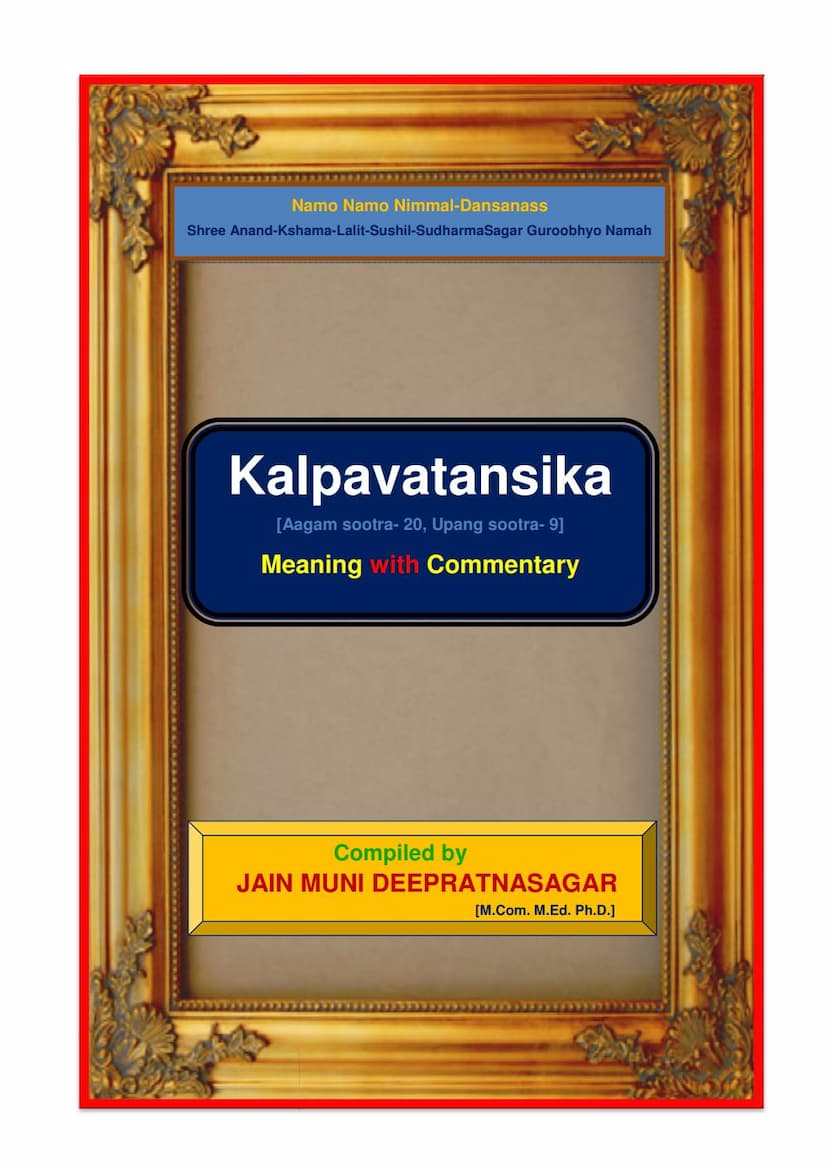Agam 20 Upang 09 Kalpvatansika Sutra English Translation
Added to library: September 1, 2025

Summary
Here's a comprehensive summary of the Jain text "Agam 20 Upang 09 Kalpvatansika Sutra English Translation" based on the provided pages:
The Kalpavatansika Sutra, identified as Upang Sutra number 9 within Aagam 20, is a Jain scripture that details the spiritual journeys and eventual liberation of ten grandsons of King Shrenik. The text is presented with a meaning and commentary, compiled by Muni Deepratnasagar.
Background and Context:
- The publication is part of an initiative to provide Jain Aagams in English for a new generation and those living abroad.
- The Kalpavatansika Sutra is categorized as an "Ang-bahya" Aagam, now known as an "Upang" Sutra. It is believed to be an upang of the Ang-Sutra "Anuttaropapaatikdasa."
- The translation is based on Hindi compilations and incorporates commentary.
- The text serves a dual purpose: to make Aagam literature accessible in English and to be available in a format (Microsoft Word) that allows for further user editing.
Content and Structure:
The Kalpavatansika Sutra contains ten chapters (Adhyayanas). The provided excerpt details the first two chapters and summarizes the remaining eight.
Chapter 1: Padma
- Introduction: Jambu Swami inquires about the second section of the Upanga, Kalpavatansika, from Sudharma Swami. Sudharma Swami reveals that the Kalpavatansika Sutra has ten chapters.
- The Ten Chapters: The ten chapters are listed as: Padma, Mahapadma, Bhadra, Subhadra, Padmabhadra, Padmasen, Padmagulma, Nalinigulma, Anand, and Nandan.
- The Story of Padma:
- The narrative begins in the city of Champa, where King Kunik rules, and his consort is Queen Padmavati. King Shrenik's wife, Kaali Devi, also resides there.
- Kaal Kumar, son of Kaali Devi and King Shrenik, had a consort named Padmavati.
- Padmavati experiences a dream of a lion and subsequently gives birth to a son named Padma.
- Similar to the story of Mahabal (mentioned as being detailed in the Bhagavati Sutra), Padma is raised in regal splendor, educated in seventy-two arts, and marries eight princesses.
- Upon hearing the discourse of Bhagavan Mahavir, Padma, like Mahabal, seeks permission from his parents and becomes an ascetic (anagaar).
- As an ascetic, Padma studies all eleven Angas and observes rigorous austerities for five years.
- He then undertakes the ultimate vow of Sallekhana (a month-long fast) and passes away while observing it.
- His spiritual destination: After his death, Ascetic Padma is reborn as a god in the Saudharma Kalp, a celestial realm with a lifespan of two Sagaropam. Upon completing his lifespan there, he will be reborn as a human in the Mahavideh area and attain liberation (Siddhahood), following the path of Dradhapratijna.
Chapter 2: Mahapadma
- Jambu Swami asks for the details of the second chapter.
- The narrative follows a similar pattern: In Champa city, King Kunik rules, and Queen Padmavati is his consort. King Shrenik's wife, Sukaali Devi, has a son named Sukaal Kumar.
- Sukaal Kumar's consort is Mahapadmaa, who experiences a dream and gives birth to a son named Mahapadma.
- The story parallels that of Padma: Mahapadma is raised regally, gets initiated, and after rigorous austerities, attains liberation.
- His spiritual destination: Mahapadma will be reborn as a god in the Ishan Kalp (another celestial realm with a maximum lifespan of two Sagaropam). After his lifespan there, he will be reborn in the Mahavideh area and achieve perfection and liberation.
Chapters 3 to 10 (Summary):
- The remaining eight chapters (Bhadra, Subhadra, Padmabhadra, Padmasen, Padmagulma, Nalinigulma, Anand, and Nandan) follow a similar narrative structure.
- The stories involve sons of the ten princes (including Kaal Kumar), with mothers often sharing similar names to their sons (e.g., Bhadra's mother is Bhadra).
- Key distinguishing factor: The primary difference lies in the duration of their ascetic practice:
- Padma and Mahapadma: 5 years each.
- Bhadra, Subhadra, and Padmabhadra: 4 years each.
- Padmasen, Padma gulma, and Nalinigulma: 3 years each.
- Anand and Nandan: 2 years each.
- Their spiritual progression: These ten individuals, all grandsons of King Shrenik, progressed through the heavens in a specific order after their initiation and death:
- Saudharma Kalp
- Ishan Kalp
- Sanatkumar Kalp
- Mahendra Kalp
- Brahma Kalp
- Lantak Kalp
- Mahashukra Kalp
- Sahasrara Kalp
- Pranat Kalp
- Achyut Kalp
- Upon completing their lifespans in these respective celestial realms, they will descend to the Mahavideh area and attain final liberation as Siddhas.
Overall Significance:
The Kalpavatansika Sutra highlights the Jain principle of detachment from worldly pleasures and the efficacy of rigorous asceticism in achieving spiritual progress and eventual liberation. It demonstrates how even those born into royal families can overcome attachment and attain a divine existence and ultimate salvation. The text provides a specific karmic trajectory for these ten individuals, illustrating a path of spiritual evolution through multiple lifetimes, culminating in the highest state of existence.